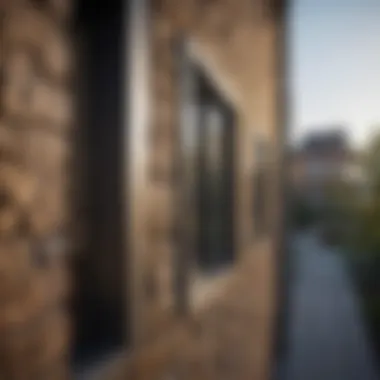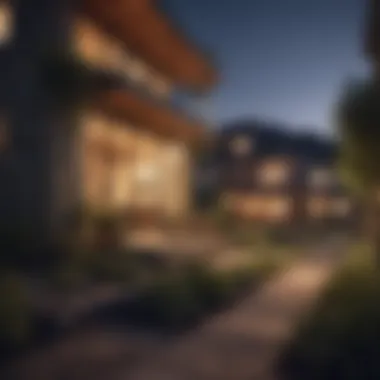Exploring Auraria Housing: Trends and Future Insights


Intro
Auraria housing is a significant topic in urban residential architecture, reflecting both historical developments and modern trends. Understanding this area can provide insights into community dynamics and aspects of living in an urban setting. The architecture found in Auraria is not just about dwelling structures; it encompasses a blend of cultural influences, historical narratives, and evolving designs.
This article serves as a comprehensive guide for those interested in the architecture of Auraria housing and the wider implications for its community. We will dive into the remarkable architectural designs, explore the interior decorating trends, and scrutinize the community impact alongside local policies.
Exquisite Architectural Designs
Unique Home Features
Auraria housing showcases a variety of architectural styles that stand out in the urban landscape. Each home often possesses unique features that echo the historical essence of the area. For instance, many properties highlight large windows that invite natural light, enhancing the livability of spaces within. Homeowners often appreciate open floor plans. These layouts not only facilitate seamless movement between spaces but also encourage social interactions among residents.
Architects often integrate modern sustainable design techniques, focusing on energy efficiency and environmental mindfulness. Homes might feature green roofs or solar panels, reflecting a movement towards more eco-conscious living.
Historical Significance
The historical context of Auraria housing adds depth to its architectural appeal. Understanding the past informs current design choices and community planning. Many buildings have roots that trace back to important eras in the city’s development.
Auraria itself was a focal point during numerous transformative periods in the region's history. The adaptations of its structures reflect changing societal needs. Restorations of these buildings have become common, preserving their unique characteristics while accommodating modern functionality. This balance of history and modernity is what makes Auraria particularly compelling.
Interior Decorating Tips
Color Schemes and Trends
Interior design in Auraria homes often reflects current trends yet respects the historical narratives of their structures. Neutral color palettes are gaining popularity, as they create a calming atmosphere and serve as versatile backdrops for various decor styles. Accent walls painted in deeper shades can bring warmth and personality to living spaces.
Natural materials, like wood and stone, are frequently used to establish a connection with the exterior environment. By incorporating these, homeowners can evoke a sense of comfort while maintaining aesthetic cohesiveness.
Space Optimization Techniques
In urban settings such as Auraria, maximizing small spaces is crucial. Homeowners are increasingly using clever storage solutions like built-in shelves and multi-functional furniture. For example, a sofa bed can be a lifesaver in smaller apartments, allowing flexibility without sacrificing comfort.
Strategically placed mirrors can create the illusion of more space and brightness within. Thus, embracing minimalism can assist in maintaining a clean, open feel to complement the unique architectural features of the home.
"Real estate is not just about location; it’s about the culture and community that resides within."
By understanding the blend of architectural designs and interior trends in Auraria, professionals and enthusiasts alike can appreciate the distinctiveness of this unique urban housing. As we look to the future, consideration of historical context, community dynamics, and modern policies will continue to shape the evolution of Auraria housing.
Intro to Auraria Housing
Understanding Auraria housing is crucial for grasping the larger narrative of urban residential architecture. This topic intertwines with various aspects such as community development, historical context, and the intricate interplay of policies affecting housing availability. Auraria, known for its unique characteristics, offers insights into current housing trends while also touching on the implications for future growth.
Housing plays a key role in shaping lives. Therefore, diving deeper into the elements of Auraria housing gives us a clear picture of the existing benefits and challenges. Various considerations arise, such as architectural styles that influence community aesthetics and livability. Additionally, policies surrounding this area can either enhance or restrict the quality of living spaces. It is vital for real estate enthusiasts and urban planners to meditate on these points.
Geographic Overview
The Auraria district is strategically located, often seen as a hub within a bustling urban landscape. Its accessibility is paramount, with proximity to major highways and public transportation options facilitating easy commutes. The area’s geographical layout encompasses schools, parks, and local businesses, directly impacting the lifestyle of its residents. The balance of residential and commercial spaces promotes a vibrant community.
This makes Auraria attractive for new residents and investors alike. Given its placement, understanding geographic specifics allows for nuanced insights into potential development areas. It also epresents the community's identity, which is molded by this geographical context.
Historical Significance


Auraria has a rich historical background that shapes its current housing landscape. Initially, the district catered to a diverse population, showcasing a tapestry of cultures. As the area evolved, so did its architectural forms, reflecting changing tastes and societal values. The significance of this history cannot be overstated; it provides a narrative arc that informs present-day policies and community dynamics.
Moreover, preservation efforts are often discussed in the context of past developments. Maintaining certain historic structures serves not only to honor the legacy of Auraria but also enhances property values in the area. Housing history acts as a foundation upon which current discussions of urban development rest.
Demographics of Residents
The resident demographics of Auraria convey essential trends that impact housing needs and preferences. A mixed population, inclusive of various age groups and socioeconomic backgrounds, resides within the area. This diversity influences local services, education requirements, and recreational facilities, shaping the overall community experience.
Understanding the demographics enables a closer look at what types of housing are most sought after. For instance, families might prioritize larger homes with access to schools, while younger professionals may seek apartments with proximity to work and nightlife. Recognizing these trends provides valuable insights for developers and policymakers aiming to meet the needs of potential residents.
The vibrant mix of demographics creates a unique community dynamic, driving innovation in housing strategies and local services.
Architectural Styles in Auraria
The architectural styles in Auraria represent a crucial aspect of this community's identity. These structures not only house residents but also reflect the cultural and historical evolution of the area. Understanding the architectural landscape provides insights into the values and aspirations of inhabitants across different eras.
Contemporary Designs
Contemporary designs in Auraria showcase innovation and creativity. The use of modern materials and techniques has allowed architects to create spaces that are functional and aesthetic. Large windows and open floor plans characterize many of these buildings, allowing for natural light to flow in and create a welcoming atmosphere.
Sustainability is often a key component in contemporary housing. Many developments incorporate energy-efficient designs, such as solar panels and high-quality insulation. These advancements not only reduce the environmental impact but also contribute to lower utility costs for residents. Moreover, outdoor spaces like green roofs and communal parks enhance the quality of life by promoting community interaction.
Contemporary styles often prioritize accessibility, ensuring that homes cater to a diverse range of needs. The integration of smart home technology is also becoming more common, making residences more comfortable and efficient. The architectural landscape reflects modern ideals while keeping the needs of future residents in mind.
Historic Preservation
Historic preservation in Auraria aims to maintain the unique character that defines the area. Many buildings showcase architectural styles from different periods, offering a visual timeline of the community's development. Preservation efforts focus on restoring original features, such as facades and interiors, that contribute to the historic ambiance.
Efforts to preserve these historic sites provide cultural education to residents and visitors alike. They also attract individuals who appreciate the artistry of older architecture. However, it requires a delicate balance with modern needs; the challenge lies in accommodating contemporary lifestyles while honoring historical integrity.
"Preserving our past is not only about respecting history but also about enriching our present and future."
Community support plays an essential role in these initiatives. Residents often become advocates for historical buildings, recognizing their significance. Various local organizations work diligently to promote awareness and appreciation for heritage sites.
By focusing on both contemporary designs and historic preservation, Auraria manages to create a diverse and dynamic housing market. This blend allows for continuous growth while valuing its rich history, offering residents a sense of place that reflects both past and present.
Community and Lifestyle
Understanding the community and lifestyle aspect of Auraria housing is essential for several reasons. First, it provides insight into how residents interact within the neighborhood, influencing social cohesion and overall quality of life. A vibrant community can enhance the living experience, creating a sense of belonging and stability. Moreover, the availability of amenities and services contributes significantly to the lifestyle choices of residents.
This section dives into the social dynamics that shape community interactions and examines how local amenities impact daily life.
Social Dynamics
Social dynamics within Auraria are characterized by a diverse population that fosters inclusivity. The community's makeup influences how residents engage with one another. Events organized at community centers and parks promote interaction. This enhanced social fabric often leads to cooperative initiatives aimed at improving neighborhood conditions.
Additionally, participation in local governance allows residents to voice their concerns and aspirations. Engaged citizens are more likely to advocate for improvements in infrastructure and services, making the community more appealing for potential newcomers.
Local Amenities and Services
The quality of local amenities and services plays a crucial role in the lifestyle of Auraria residents. Accessibility to education, healthcare, and recreational facilities significantly enhances the living experience.
Education


Education in Auraria is robust. The presence of various educational institutions allows residents to choose from different curriculums and teaching styles. This is beneficial as families often prioritize quality schooling for their children. Schools here tend to foster not just learning but also community engagement through events and activities. However, disparities in resources exist among schools, which may affect overall educational effectiveness for some communities.
Health Care
Health care access is another significant aspect of life in Auraria. Proximity to hospitals and clinics contributes to a higher quality of life. Residents benefit from various healthcare options, including specialized services. This accessibility allows for timely medical attention, crucial in emergencies. Yet, challenges remain, such as insurance coverage limitations and service availability, particularly for underprivileged communities.
Recreation
Recreation facilities in Auraria are plentiful, providing spaces for sports, fitness, and relaxation. Parks and community centers become hubs for activities, enhancing social interaction. Engaging in recreational activities is vital for mental and physical health, making them a popular choice for families and individuals.
Unique features such as art installations or public events hosted in these recreational spaces often attract a diverse crowd, fostering community spirit. However, maintenance of these facilities can sometimes lag, affecting accessibility and desirability for residents.
"A strong community is built on active participation and engagement, leading to improved overall living conditions."
In summary, the community and lifestyle in Auraria are interconnected elements that shape residents' experiences. Strong social ties, combined with robust access to education, healthcare, and recreational activities, create an appealing living environment. Understanding these factors is crucial for anyone looking to delve deeper into Auraria housing and its implications for resident life.
Housing Policies and Regulations
Housing policies and regulations play a critical role in shaping the dynamics of Auraria's residential landscape. These frameworks govern how land can be utilized and impact the affordability and sustainability of housing developments. Understanding these policies is essential for potential homeowners, developers, and urban planners alike. They determine what can be built, where, and under what conditions. Such regulations can promote responsible development and ensure that the needs of the local population are met.
Zoning Laws
Zoning laws serve as the backbone of urban planning. They categorize land into zones, such as residential, commercial, or mixed-use, dictating what types of buildings can exist in particular areas. In Auraria, zoning laws aim to maintain the character of neighborhoods while fostering development that aligns with community goals. For instance, areas designated for low-density housing may restrict the construction of large apartment complexes.
These laws often include regulations regarding building heights, setbacks from the street, and even the number of units in a building. This control helps to prevent overcrowding and preserves green spaces, crucial for maintaining the aesthetic and environmental quality of the region.
Affordability Initiatives
In response to rising living costs, affordability initiatives are vital to ensure that a diverse population can reside in Auraria. These initiatives often involve various strategies aimed at increasing access to affordable housing. These strategies could include tax incentives for developers who incorporate affordable units into new projects or funding for community housing programs.
Partnerships between governmental bodies and non-profit organizations have also emerged to support affordable housing. Such initiatives will not only help in providing shelter but also strive to create inclusive communities where different demographics can coexist. Ensuring that families and individuals can live in desirable areas without financial strain benefits the overall social fabric of Auraria.
Sustainable Practices
As urban areas expand, the implementation of sustainable practices in housing becomes increasingly urgent. In Auraria, various programs encourage developers to adopt environmentally friendly building practices. This involves using sustainable materials, optimizing energy efficiency, and incorporating renewable energy sources, such as solar panels.
Sustainable housing policies have numerous advantages, including reducing the carbon footprint of buildings, lowering utility costs for residents, and enhancing the overall livability of communities. Incentives such as grants or rebates for incorporating green features further promote these practices. Ultimately, these efforts contribute to a healthier environment and a more sustainable future for Auraria.
"Well-developed housing policies can enhance the quality of life for residents and set a solid foundation for sustainable urban growth."
In summary, the interaction between zoning laws, affordability initiatives, and sustainable practices creates a framework that guides the future of Auraria housing. These policies are instrumental in fostering a vibrant and inclusive community, where growth is managed effectively, and all residents can thrive.
Economic Impact of Auraria Housing
The economic landscape of Auraria housing is critically important for understanding its broader implications on the community, residents, and the real estate market. Housing not only serves as a fundamental need for individuals but also acts as a driving force in the local economy. A well-developed housing sector can stimulate job creation, encourage investment, and enhance the overall quality of life. For residents and stakeholders, comprehending the economic impact is essential when considering home ownership, urban development, and long-term investments.
Real Estate Trends
Real estate trends in Auraria reflect shifts in the market that may impact future developments. Over the past few years, there has been a notable increase in property values in the region. This growth is influenced by several factors:
- Urban revitalization: Efforts to renovate older structures have made the area more attractive. Upgrading amenities has drawn in new residents, particularly younger professionals.
- Housing demand: There is a steady demand for housing, driven by population growth and a migration of individuals seeking urban living experiences. This elevates competition among buyers, contributing to higher prices.
- Sustainability initiatives: Interest in sustainable housing options has risen. Developers are increasingly focusing on eco-friendly construction methods, which appeal to environmentally-conscious buyers. Such trends can result in a premium on properties that incorporate green technologies.
These trends have created an evolving real estate market that requires potential homeowners and investors to stay informed about current conditions.


Investment Opportunities
Investment in Auraria housing offers various opportunities, attracting both local and international investors. These opportunities can include:
- Residential Development: Investing in residential properties either for rental or resale is a viable option. The continuing demand for housing provides a promising return on investment.
- Commercial Real Estate: With economic growth, there is a surge in demand for commercial spaces. Restaurants, shops, and offices are essential to support the growing population, making this an attractive area for commercial property investments.
- Renovation Projects: Older buildings often present unique investment opportunities. Investors can look for undervalued properties that require refurbishment. By modernizing these spaces, they can tap into higher market rates, thus increasing profitability.
"Understanding the economic impact of housing is crucial for making informed decisions about investments and community development."
Comparative Analysis with Other Housing Developments
The importance of conducting a comparative analysis of Auraria housing with other developments is profound. It enables stakeholders to grasp the unique characteristics that define Auraria housing. Such an analysis highlights both distinctions and similarities that inform housing policies, market trends, and community dynamics. By examining Auraria in relation to other regions, one can explore challenges and opportunities that might be less visible when viewed in isolation. This comparative approach adds depth to the understanding of what makes Auraria housing truly unique.
Regional Comparisons
When comparing Auraria housing with other regional developments, a few key factors come into play. The geographical context, economic conditions, and local housing policies can significantly influence the residential landscape.
- Geographic Context: Auraria’s location provides distinct benefits and challenges. It is close to urban centers, offering access to various amenities and services. In contrast, some other regions might lack such proximity, making them less desirable for homebuyers.
- Economic Conditions: The economic health of a region profoundly affects housing markets. Auraria often benefits from a stable job market, attracting a diverse population. Some regions face economic downturns, impacting housing demand. This difference in economic vitality plays a crucial role in shaping housing prices and availability.
- Local Housing Policies: Regulatory frameworks governing housing in Auraria contrast with those in other regions. Policies on zoning, development incentives, and housing affordability initiatives can dictate market behavior. Regions with strict zoning laws may strangle housing supply, whereas Auraria’s policies might promote greater diversity in housing options.
These comparisons reveal how Auraria housing operates within a broader context. They underscore its relative strengths and weaknesses, informing decisions for buyers, developers, and policymakers.
National Trends
When looking at Auraria housing through the lens of national trends, there are various noteworthy aspects to consider. These trends provide an overarching framework that shapes housing markets across the country, influencing local dynamics seen in Auraria.
- Urbanization: Throughout the United States, urban areas are experiencing a significant influx of residents. This shift brings forth increased interest in housing within vibrant urban environments such as Auraria.
- Sustainability Practices: Eco-friendly constructions and sustainability initiatives are gaining traction nationally. Auraria has the opportunity to lead in this area by adopting practices that enhance environmental performance, setting a precedent for other regions.
- Remote Work Influence: The rise of remote work has altered housing demands. People may now seek homes that offer more space or unique features. Auraria can benefit from attracting remote workers who appreciate its blend of urban and residential living.
Understanding these national trends helps contextualize Auraria’s housing market within the larger tapestry of American real estate. By recognizing these patterns, stakeholders can better anticipate changes and adapt strategies accordingly.
"Comparative analysis allows us to uncover hidden nuances in housing markets that would otherwise go unnoticed."
Engaging in a thorough comparative analysis not only provides clarity regarding Auraria housing but also facilitates informed decision-making for all parties involved.
Future of Auraria Housing
The future of Auraria housing holds significant importance in understanding how urban residential spaces evolve alongside community needs and trends. This topic not only informs potential homeowners and investors but also guides urban planners and policymakers. As we delve deeper into this subject, we will explore emerging trends that shape the housing landscape and the challenges that may hinder progress.
Emerging Trends
Several observable trends are influencing the future of housing in Auraria. These trends reflect shifting societal values and technological advancements.
- Sustainability Initiatives: There is a growing emphasis on green building practices. Developers are increasingly prioritizing eco-friendly materials and energy-efficient systems. This commitment to sustainability not only enhances the environment but also reduces long-term operational costs for homeowners.
- Smart Home Technology: Innovations in technology are transforming residential living. Homes equipped with smart devices offer improved security and energy management. As the demand for such features rises, new constructions will likely integrate these technologies by default.
- Mixed-Use Developments: The rise of mixed-use developments signifies a shift towards creating vibrant communities. These projects combine residential, commercial, and recreational spaces. This approach fosters community interaction and reduces reliance on transportation, making Auraria more walkable and integrated.
- Affordable Housing Solutions: Given the growing concerns about housing affordability, developers are exploring alternative housing models. Concepts like tiny homes and co-housing arrangements may become more prevalent, catering to diverse income levels and preferences.
"Understanding these trends is crucial for anyone considering investment or relocation in Auraria. They represent the intersection of lifestyle needs and economic realities."
Challenges Ahead
Despite the promising trends, several challenges threaten the future of housing in Auraria. Addressing these challenges will require collaboration among stakeholders, including government bodies, developers, and the community.
- Regulatory Hurdles: Zoning laws and building codes can impede innovative housing solutions. Navigating these regulations can delay projects and increase costs. Adjustments to these frameworks are necessary for supporting new housing initiatives.
- Economic Constraints: Economic fluctuations can impact housing demand and affordability. In times of recession, the risk of stalled developments rises, leading to fewer housing options for residents. Stability in the economy is essential for sustainable growth.
- Gentrification Risks: As Auraria becomes more attractive, gentrification poses a significant threat. Long-time residents may face displacement as property values increase. Balancing development with the preservation of community character is necessary for preventing this issue.
- Environmental Challenges: Climate change poses risks that affect housing security. Rising temperatures and unpredictable weather patterns can influence construction practices and housing resilience. Addressing these environmental factors will be critical for future planning.
Finale
The conclusion of this guide serves as a crucial checkpoint for reflecting on the multifaceted subject of Auraria housing. It encapsulates the nuances discussed from historical evolution to modern trends, providing a framework for understanding its relevance today. The importance of this topic cannot be overstated. Housing in Auraria impacts local communities, the economy, and future development decisions.
Recap of Key Points
To summarize the salient aspects covered in this article:
- Geographic Influence: Auraria's location presents unique advantages and challenges that shape housing arrangements.
- Architectural Diversity: The blend of contemporary and historical styles contributes to the area’s aesthetic significance.
- Community Dynamics: Understanding demographic influences is essential for both residents and investors.
- Regulatory Environment: Housing policies and zoning laws play a key role in affordability and sustainable practices.
- Economic Potential: Real estate trends highlight investment opportunities that can redefine community outlooks.
- Comparative Analysis: Insight into how Auraria stands relative to other regions broadens perspectives on housing options.
- Future Outlook: Emerging trends and challenges will dictate the evolution of Auraria housing moving forward.















